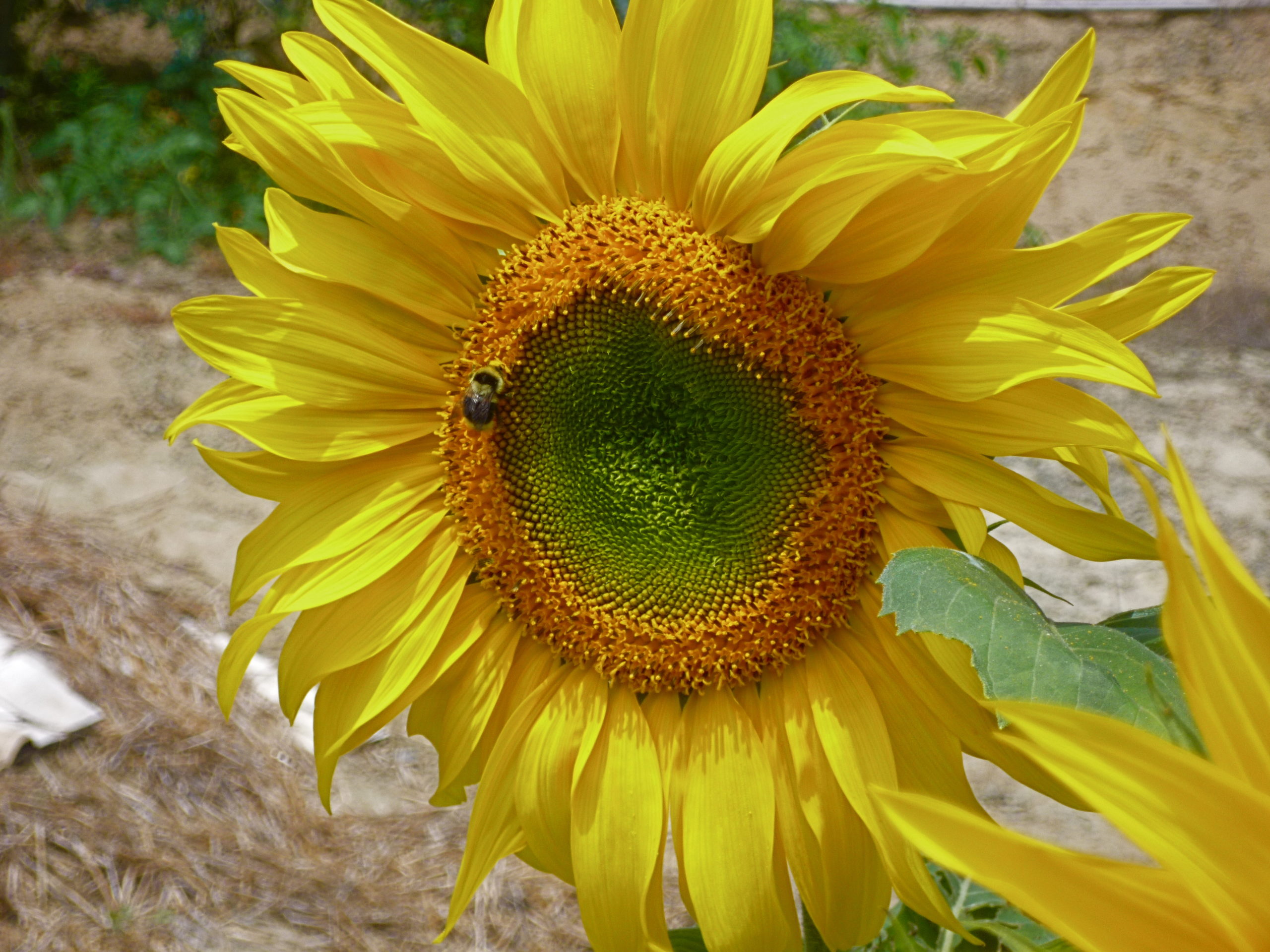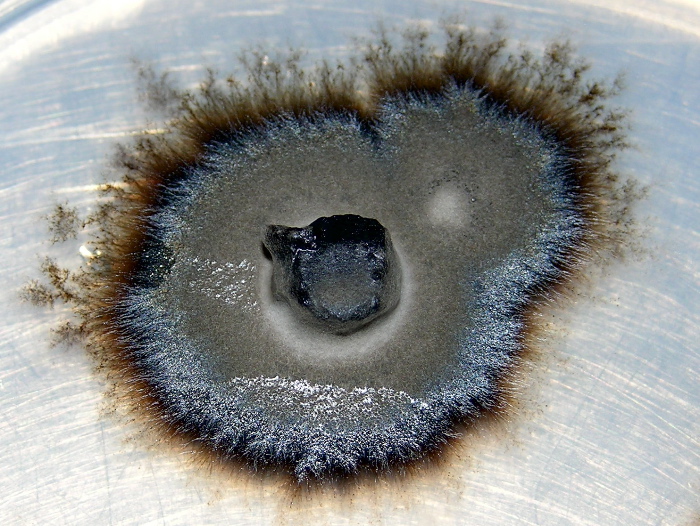Multifaceted Symbiosis Points to Creation
Nature is filled with examples of mutualistic symbiosis—a relationship in which dissimilar species benefit from the association. Obligatory mutualistic symbiosis is where two or more dissimilar organisms depend upon one another for survival. A recently conducted field experiment reveals one of the most complex and multifaceted examples of obligatory mutualistic symbiosis ever discovered. This discovery challenges biological evolution but affirms biblical creation.
An example of obligatory mutualistic symbiosis (obligatory mutualism) would be flowering plants and bees (see figure 1). Flowering plants provide bees with nectar—their primary food source and available only from the flowers of such plants. Bees are endowed with specially designed body hair such that when they visit flowers to harvest nectar, their body hair pollinates the flowers.
Figure 1: Bee Getting Nectar from a Sunflower While Its Body Hair Pollinates the Flower Image credit: Hugh Ross
The relationship between bees and flowers is obligate. Bees cannot survive without flowering plants. Flowering plants cannot reproduce without pollinating insects like bees.
Other species benefit from the mutualism between bees and flowering plants. We humans, for example, harvest honey from bees and fruit from flowering plants—resources that exist only because of the mutualistic symbiotic relationship between bees and flowering plants.
Challenge to Evolution
Obligate mutualism presents an obvious challenge to naturalistic evolution models. Such models must explain how the two, three, or four symbiotic partner species emerged at the same time and at the same location, with all the morphological (structural) and biochemical features needed to transmit the absolutely essential goods and services to one another.
Evolutionists believe they have an answer—the theory of coevolution, where they hypothesize that distinct species evolve through small steps of increasingly cooperative interactions with one another. However, if (1) the small steps offer little or no survival advantage to the interacting species; or (2) all the steps must be in place before any significant survival advantage is realized; or (3) the distinct species cannot survive until the symbiotic structures and relationships are in place, then this theory reduces to a fantastically improbable multitude of simultaneous lucky coincidences amid the undirected chaos of nature.
The challenge to evolution becomes more potent when the mutualism is especially complex and involves multiple species. Such is what the team that performed a recently conducted field experiment discovered.
Arbuscular Mycorrhizal Fungi Field Experiment
A team of six Chinese and British microbiologists led by Lin Zhang at China Agricultural University published a paper1 in which they reported results of a field experiment they conducted on arbuscular mycorrhizal fungi (AMF). Zhang’s team first noted that AMF interact (see the featured image) with both the roots of vascular plants (plants with xylem and phloem that act as a hydraulic system to bring water and nutrients up from the soil to the leaves and food from the leaves to the rest of the plants) and the soil microbial community to perform multiple functions. These functions are either beneficial or, in most cases essential, to the survival of the AMF and the relevant soil microbes and vascular plants.
Some of these functions include the AMF (see figure 2) partnering with specific microbial species to harvest carbon, nitrogen, sulfur,2 and phosphorus compounds from the soil and transforming these compounds into molecular forms that vascular plants can use. The vascular plants, in turn, supply the AMF with the sugars and lipids they need to survive and grow. Other functions include delivery systems whereby the microbes, AMF, and vascular plants can trade vital resources with one another. AMF also enhance the uptake of liquid water by vascular plants and protect soils and soil microbes from wind and water erosion. In grasslands, AMF help seedlings get established in the soil.3 One study showed that AMF even operate as a communications network to warn vascular plants of coming attacks by aphids.4
Figure 2: Arbuscular Mycorrhizal Fungus Isolated from a Vascular Root Image credit: David Midgley
The means by which most of these functions operate have been explained in previous research studies.5 However, Zhang and his team pointed out that the pathway by which AMF and soil bacteria interact to harvest phosphorus and transform the phosphorus into a mineral that vascular plants can readily assimilate was far from clear. Hence, they performed a field experiment to investigate how the phosphorus harvesting occurs and how this phosphorus is transformed into the needed mineral form.
Zhang and his collaborators placed AMF hyphae (long, branching filamentous fungi cells) in root-free soil. They placed PVC pipes that were sealed with membranes possessing different sizes of pores (30 or 0.45 micron diameter) in the soil to allow or deny the AMF hyphae access to organic phosphorus in the soil.
The microbiologists observed that “the bacterial communities attached to the AMF hyphae surface were significantly different from those in the bulk soil.”6 They further observed the AMF hyphae specifically recruiting and providing for bacterial species that produced alkaline phosphatase, the phosphorus mineral that vascular plants need. They determined, too, that the AMF hyphae were unable to manufacture alkaline phosphatase. Thus, a crucial part of the AMF-vascular plant-soil microbe symbiosis is the capability of AMF hyphae to attract, house, and provide nutrients for the alkaline-phosphatase-manufacturing bacteria, plus the capability of AMF hyphae to efficiently deliver alkaline phosphatase to the roots of vascular plants on which it resides.
The Zhang team’s experiment establishes that the AMF-vascular plant-soil microbe symbiosis is much more interdependently functional than previously thought. All the different symbiotic relationships must be in place and efficiently operating for any one of them to be successful.
A World without AMF-Vascular Plant-Soil Microbe Symbiosis
Of all the known examples of mutualism, the one among vascular plants, AMF, and mineral-processing soil bacteria is the most pervasive and the most critical for human beings and human civilization. Over 80 percent of all vascular plants critically depend upon AMF and the soil microbes that AMF recruits and manages for their survival. This 80+ percent includes all the crop species that humans and their domesticated animals depend on for food.
Without the efficient multi-functionality of AMF-vascular plant-soil microbe symbiosis, the amount of carbon that would be sequestered in soils and the tissues of vascular plants would be just a tiny fraction of what they actually are. In this scenario, our atmosphere would contain several times as much carbon dioxide. That amount in the atmosphere would cause a climate runaway—where the Sun’s heat trapped by that much carbon dioxide would cause all of Earth’s ice and liquid water to be transformed into water vapor. Like carbon dioxide, water vapor is a greenhouse gas. Thus, without AMF-vascular plant-soil microbe symbiosis, Earth’s surface would become much too hot for any life-forms other than thermophilic (heat-loving) bacteria to survive.
Bigger Challenge for Biological Evolution Models
As noted, the challenge to naturalistic models for biological evolution becomes all the more vexing when mutualism is complex and involves multiple species. The problem becomes more intractable when the symbiosis is as pervasive as it is for AMF-vascular plant-soil microbe symbiosis. Evolutionary explanations become even more improbable when the mutualism is perfectly timed to compensate for the brightening of the Sun, for preventing a climate runaway, and for providing the needed resources—food and biodeposits—for launching and sustaining global human civilization. All of these intricate designs and functions are simultaneously needed to be in the just-right locations and at the just-right times for the AMF-vascular plant-soil microbe symbiosis to operate and for this symbiosis to provide the critical resources needed to permit the existence of terrestrial birds, mammals, and humans. It seems obvious that nothing less than the activity of the supernatural, super-intelligent Creator revealed in the Bible can explain all the fine-tuned phenomena.
Featured image: Arbuscular Mycorrhizal Fungi Nodules along a Clover Plant Root. Image credit: Natural Resources Conservation Service, United States Department of Agriculture
Endnotes
- Lin Zhang et al., “Arbuscular Mycorrhizal Fungi Stimulate Organic Phosphate Mobilization Associated with Changing Bacterial Community Structure under Field Conditions,” Environmental Microbiology20 (July 2018): 2639–51, doi:10.1111/1462-2920.14289.
- James W. Allen and Yair Shachar-Hill, “Sulfur Transfer through an Arbuscular Mycorrhiza,” Plant Physiology149 (January 2009): 549–60, doi:10.1104/pp.108.129866.
- Marcel G. A. Van Der Heijden, “Arbuscular Mycorrhizal Fungi As Support for Seedling Establishment in Grassland,” Ecology Letters7 (April 2004): 293–303, doi:10.1111/j.1461-0248.2004.00577.x.
- Zdenka Babikova et al., “Underground Signals Carried through Common Mycelial Networks Warn Neighboring Plants of Aphid Attack,” Ecology Letters16 (July 2013): 835–43, doi:10.1111/ele.12115.
- Adam B. Cobb, Gail W. T. Wilson, and Carla L. Goad, “Linking Sorghum Nutrition and Production with Arbuscular Mycorrhizal Fungi and Alternative Soil Amendments,” Journal of Plant Nutrition and Soil Science181 (April 2018): 211–19, doi:10.1002/jpln.201700052; Megan K. Nasto et al., “Interactions among Nitrogen Fixation and Soil Phosphorus Acquisition Strategies in Lowland Tropical Rain Forests,” Ecology Letters 17 (October 2014): 1282–89, doi:10.1111/ele.12335; Gail W. T. Wilson et al., “Soil Aggregation and Carbon Sequestration Are Tightly Correlated with the Abundance of Arbuscular Mycorrhizal Fungi: Results from Long-Term Field Experiments,” Ecology Letters 12 (March 2009): 452–61, doi:10.1111/j.1461-0248.2009.01303.x; Yina Jiang et al., “Plants Transfer Lipids to Sustain Colonization by Mutualistic Mycorrhizal and Parasitic Fungi,” Science 356 (June 16, 2017): 1172–75, doi:10.1126/science.aam9970; Leonie H. Luginbuehl et al., “Fatty Acids in Arbuscular Mycorrhizal Fungi Are Synthesized by the Host Plant,” Science 356 (June 08, 2017): 1175–78, doi:10.1126/science.aan0081; Alan C. Gange, Valerie K. Brown, and David M. Aplin, “Multitrophic Links between Arbuscular Mycorrhizal Fungi and Insect Parasitoids,” Ecology Letters 6 (December 2003): 1051–55, doi:10.1046/j.1461-0248.2003.00540.x.
- Zhang et al., “Arbuscular Mycorrhizal Fungi Stimulate Organic Phosphate Mobilization,” p. 1.








